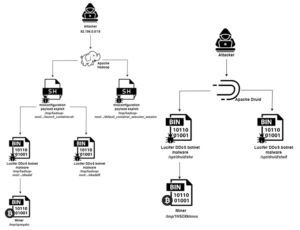BotNets Technology Hacking Automation Scripts
Part 1: BotNets – What Are They and What Is Their Purpose?
What Are Botnets?
A botnet is a network of compromised computers or devices, known as “bots” or “zombies,” which are controlled remotely by an attacker, often referred to as a “botmaster” or “bot herder.” These botnets can be used to perform a variety of malicious activities, typically without the knowledge of the device owners.
Evolution of Botnets
- Early Days:
- IRC-Based Botnets (1990s): The earliest botnets used Internet Relay Chat (IRC) to command infected machines. These bots were often created for fun or minor pranks but set the stage for more serious threats.
- Example: The “Sub 7” and “Back Orifice” trojans were among the first to create such networks.
- 2000s – Rise of Complexity:
- Peer-to-Peer (P2P) Networks: Botnets evolved to use P2P networks to avoid centralized control and improve resilience.
- Example: The “Storm Worm” utilized a P2P architecture to distribute commands.
- 2010s – Advanced Botnets:
- Botnets as a Service: The commercialization of botnets turned them into a service for hire.
- Example: The “Mirai” botnet, which primarily targeted IoT devices, became infamous for its scale and impact.
- 2020s – Sophisticated and Distributed Attacks:
- Targeted Attacks and Cryptojacking: Modern botnets often focus on specific targets or exploit devices for cryptojacking.
- Example: “Emotet” and “TrickBot” are known for their sophisticated modularity and targeted attacks.
Common Uses of Botnets
- Distributed Denial of Service (DDoS) Attacks:
- Overwhelm a target server or network with traffic to make it inaccessible.
- Spam and Phishing:
- Distribute large volumes of spam emails or phishing attempts to harvest personal information.
- Data Theft:
- Steal sensitive information from compromised systems.
- Cryptojacking:
- Utilize infected devices to mine cryptocurrency without the user’s consent.
- Click Fraud:
- Automate clicks on online ads to generate fraudulent revenue.
Key Terminology
- Botmaster/Bot Herder: The individual who controls the botnet.
- Command and Control (C2): The server or infrastructure used to send commands to the bots.
- Infection Vector: The method by which the botnet malware is spread (e.g., phishing, exploit kits).
- Zombies/Bots: Infected devices within the botnet.
Popular Variants
- Mirai:
- Known for its large-scale attacks using IoT devices.
- Exploits default passwords on IoT devices.
- Emotet:
- Initially a banking trojan, evolved into a modular botnet used for a variety of malicious activities.
- Known for its resilience and ability to distribute other malware.
- Zeus/Zbot:
- A banking trojan that evolved into a powerful botnet for stealing financial credentials.
- Conficker:
- One of the largest and most infamous botnets, known for its ability to spread through vulnerabilities in Windows operating systems.
Part 2: A Basic Example of a Botnet
Overview
Let’s look at a simple Python script example to demonstrate the concept of a botnet. This example is for educational purposes only and should not be used for any malicious activities.
Basic Botnet Example in Python
# Example BotNet In Python:
import socket
import threading
# This is the bot (client) code.
def connect_to_server():
server_ip = "127.0.0.1" # IP of the command and control server (for demonstration)
server_port = 12345 # Port of the command and control server
s = socket.socket(socket.AF_INET, socket.SOCK_STREAM)
try:
s.connect((server_ip, server_port))
print("Connected to server")
while True:
command = s.recv(1024).decode('utf-8')
if command == "shutdown":
print("Shutting down...")
break
else:
# Execute command
print(f"Received command: {command}")
# For security reasons, this part is left out in this example.
# You could use os.system(command) to execute commands.
except Exception as e:
print(f"Error: {e}")
finally:
s.close()
def main():
# Create multiple threads to simulate multiple bots
for i in range(5): # Simulating 5 bots
t = threading.Thread(target=connect_to_server)
t.start()
if __name__ == "__main__":
main()
Explanation
- Socket Setup:
- The
socketlibrary is used to create a network connection. The bot connects to a predefined IP address and port number of the command and control (C2) server.
- The
- Connection Handling:
- The
connect_to_server()function establishes a connection to the C2 server and listens for commands.
- The
- Command Execution:
- The bot waits for commands from the C2 server. If it receives a command (e.g., “shutdown”), it performs the action. In a real-world scenario, commands could be anything, including executing system commands or sending data.
- Multithreading:
- Multiple threads are created to simulate multiple bots connecting to the C2 server concurrently. Each thread represents an individual bot.
- Error Handling:
- Basic error handling is in place to catch and display any exceptions that occur during the connection or execution process.
Note
This example demonstrates a simplified version of a botnet client. In real-world scenarios, botnets are more complex and include additional features such as encryption, obfuscation, and advanced command structures. This script is provided for educational purposes to understand the basic principles of how botnets operate.
Related Links:
Home Network Router Attacks
BotNet Archive – For Educational Purposes Only!



